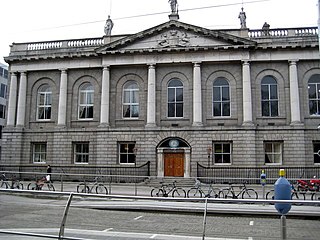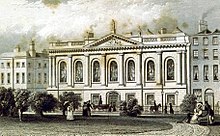
Abraham Colles was Professor of Anatomy, Surgery and Physiology at the Royal College of Surgeons in Ireland (RCSI) and the President of RCSI in 1802 and 1830. A prestigious Colles Medal & Travelling Fellowship in Surgery is awarded competitively annually to an Irish surgical trainee embarking on higher specialist training abroad before returning to establish practice in Ireland.

The Royal College of Surgeons in Ireland (RCSI) is a not-for-profit medical professional and educational institution, which is also known as RCSI University of Medicine and Health Sciences. It was established in 1784 as the national body for the surgical branch of medicine in Ireland, with a role in supervision of training, and as of 2021 provides a broad range of medical education in multiple countries.

Arthur Jacob (1790–1874) was an Irish ophthalmologist. He is known for founding several hospitals, a medical school, and a medical journal. He contributed to science and academia through his 41-year term as Professor of Anatomy at the Royal College of Surgeons in Ireland (RCSI) and as the first Irish ocular pathologist. He was elected President of RCSI in 1837 and 1864.

James Little was an Irish medical practitioner. After spending an early part of his career as a ship's surgeon, surviving a shipwreck, he became chief physician at the Adelaide Hospital in Dublin and Regius Professor of Physic at Trinity College Dublin.

Samuel Croker-King was an Irish surgeon who was associated with Doctor Steevens' Hospital in Dublin for sixty years. He was the first president of the Royal College of Surgeons in Ireland (RCSI), from 1784 to 1785. He is thought to have saved the life of the child who became the Duke of Wellington. He invented his own trepanning device.

John Whiteway was a Dublin surgeon who was the second president of the Royal College of Surgeons in Ireland (RCSI) in 1786.

Robert Bowes was the President of the Royal College of Surgeons in Ireland (RCSI) in 1787. He was Surgeon to the Charitable Infirmary, Inns Quay, Dublin, and also Surgeon to Simpson's Hospital. He was a member of the Dublin Society of Surgeons, who petitioned the King in 1781 for the foundation of the Royal College of Surgeons.

Philip Woodroffe was the resident surgeon at Dr Steevens' Hospital in Dublin for over 30 years. Several eminent surgeons were apprenticed to him. He was the president of the Royal College of Surgeons in Ireland (RCSI) in 1788.

Ralph Smith O'bré was an Irish physician who was the president of the Royal College of Surgeons in Ireland (RCSI) in 1790. He served as an army surgeon before setting up practice in Dublin where he became wealthy. He invented a popular double tracheostomy tube.

Solomon Richards was an Irish surgeon who served four terms as president of the Royal College of Surgeons in Ireland (RCSI) in 1794, 1803, 1808, and 1818. He achieved fame by performing a tracheotomy in public for which act he featured in a satirical poem in The Metropolis. He was praised for his philanthropy and noted for his puns and bon mots. He was said to be the "fattest surgeon in the United Kingdom".

Gustavus Hume was the president of the Royal College of Surgeons in Ireland (RCSI) in the first part of 1795. He specialised in the diseases of children. He was one of the surgeons who examined the body of the journalist William Jackson after he died from poisoning in a Dublin court in 1795 while awaiting sentencing for high treason.

John Creighton was the president of the Royal College of Surgeons in Ireland (RCSI) in 1812 and 1824.

Patrick Cusack Roney or Rooney was an Irish physician who was President of the Royal College of Surgeons in Ireland (RCSI) in 1814 and 1828.

James Henthorn was the president of the Royal College of Surgeons in Ireland (RCSI) in 1822.

James William Cusack was the president of the Royal College of Surgeons in Ireland (RCSI) in 1827, 1847, and 1858.

William Auchinleck was the president of the Royal College of Surgeons in Ireland (RCSI) in 1829.

Thomas Edward Beatty was an Irish physician, and the president of the Royal College of Surgeons in Ireland (RCSI) in 1850.

Andrew Ellis was the president of the Royal College of Surgeons in Ireland (RCSI) in 1849.

Robert Harrison M.R.C.S. I., M.R.I.A. was an Irish surgeon and anatomist. He was the president of the Royal College of Surgeons in Ireland (RCSI) in 1848.

Terence John MillinFRCSI FRCS LRCP was a British-born Irish urological surgeon, who in 1945, introduced a surgical treatment of benign large prostates using the retropubic prostatectomy, later known as the Millin's prostatectomy, where he approached the prostate from behind the pubic bone and through the prostatic capsule, removing the prostate through the retropubic space and hence avoided cutting into the bladder. It superseded the technique of transvesical prostatectomy used by Peter Freyer, where the prostate was removed through the bladder.









